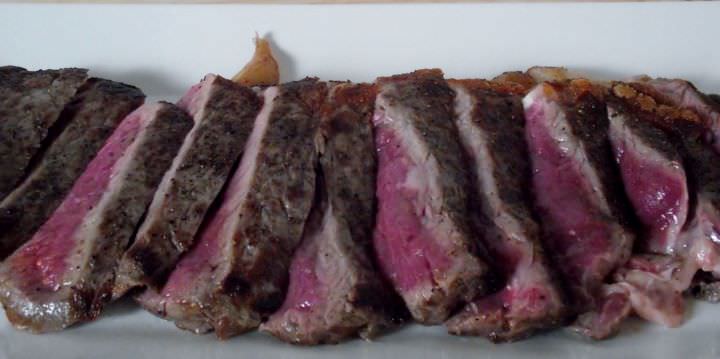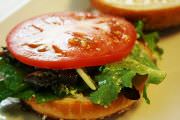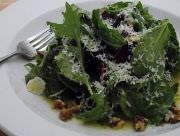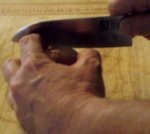Proper Meat Temperature
You no doubt have heard people say you can tell the temperature by the feel of the meat. You can after a while, but each cut of meat is slightly different and the feel at a particular temperature is different. The way a New York feels at medium-rare is different from the way a rib eye feels at medium rare and both feel different than a top-sirloin at medium-rare. You have to cook a lot of meat to develop this sense.
 Rare NY Strip Steak
Rare NY Strip SteakCooking times for meat: I wish I could tell you that it takes a specific number of minutes to hit rare or medium-rare, or well done, but I can't. Meat cooking times are a guideline at best and it takes trial and error to hit specific meat temperatures.
When you're grilling steaks the challenges are: steaks are different thicknesses, grills are different temperatures, and grill heights are different. There are just too many variables. Even the weather affects the timing, it takes longer in winter to reach the desired temperature than it does in the summer. While there is a little more control cooking under a broiler or pan searing you're still left with the problem of thickness. A half inch thick steak will hit medium long before a one or two inch thick steak will.
Back to those guidelines: Roughly it takes; 1 to 2 minutes on each side for very rare, 2 to 5 minutes on each side for rare, 4 to 6 minutes per side for medium-rare, 5 to 7 minutes per side for medium, 6 to 8 minutes per side for medium-well, 7 to 10 minutes per side for well done, and 8 to 12 minutes per side for very well done. Again, this depends on the thickness of the meat, temperature of the grill or pan...etc.
Meat cooking times are a guideline, as I said, but meat cooking temperatures will give you precise results every time.
Meat Temperature Guide
The meat temperatures listed, below, are not the USDA recommended safe minimum cooking temperatures. The temperatures listed below are the temperatures that professional kitchens use.
The lower temperatures on the right hand side, within a range (48° to 51° C OR 120° to 125° F), are the temperatures you want to remove your meat from the heat source, and allow it to rest. If you pull your meat off at the lower temperatures, on the right hand side, and allow it to rest it should hit the higher temperatures, on the left hand side.
Steaks and Roasts
- RARE - 48° to 51° C / 120° to 125° F
- MEDIUM RARE - 54° to 57° C / 130° to 135° F
- MEDIUM - 60° to 63° C / 140° to 145° F
- MEDIUM WELL - 65° to 68° C / 150° to 155° F
- WELL - 71° to 74° C / 160° to 165° F
- GROUND BEEF 71° C / 160° F
Lamb
- RARE - 46° to 48° C / 115° to 120° F
- MEDIUM-RARE - 54° C / 130° F
- MEDIUM - 60° C / 140° F
- MEDIUM-WELL - 63° C to 65° C / 145° to 150° F
- WELL-DONE - 65° to 68° C / 150° to 155° F
- GROUND LAMB - 71° C / 160° F
Pork
- MEDIUM RARE 60° C / 140° F
- MEDIUM 63° C / 145° F
- WELL-DONE 71° C / 160° F
- GROUND PORK 71° C / 160° F
Poultry
- WHOLE CHICKEN - 71° C / 160° F
- THIGHS, LEGS, WINGS, BREASTS - 71° C / 160° F
- GROUND POULTRY - 74° C / 165° F
- WHOLE TURKEY - 65° C / 150° F
After a one hour rest, a whole turkey can increase 15 to 20 in temperature.
The most accurate way to cook a steak, or any meat, is to use a temperature probe. You insert the probe so that the tip is in the center of the meat, not touching bone. When the thermometer registers your set temperature, you remove the meat from the heat. Remember to set your temperature a few degrees lower to account for carryover cooking.
If I am cooking thin cuts of meat, or small birds, I usually set my temperature 5 degrees lower than I want the meat at. If I am cooking a large roast I set it 10 degrees lower than I want. With whole turkeys I set my temperature 15 degrees lower than my target temperature. This way as the meat rests and the carryover cooking continues to raise the meat temperature it won't overcook.
Black and Blue Steaks
Black and blue steaks need to be done in a sauté pan that has been heated over high heat until it is smoking hot, I'm talking seriously hot here. You literally sear the side, about 20 to 30 seconds to 2 to 3 minutes depending on the cut, pick it up, flip it over, and sear the other side for 20 to 30 seconds to 2 to 3 minutes then immediately transfer it to a rack and rest it for about a minute. With a black and blue steak there is no measurable residual cooking because it isn't on the heat long enough. Since there is no appreciable carryover cooking you really don't need to rest it any longer. That one minute rest allows any residual heat on the surfaces to dissipate.
With black and blue steaks there is no need to bring them to room temperature before cooking them. You are essentially eating a raw steak that is meant to be cold in the center. Since you are only pan searing for seconds to minutes, the meat temperature inside the steak should be cold. If you let it come to room temperature the inside of the steak is going to be room temperature.
A common choice for black and blue steaks are filet mignon. Because they are cut so thick to begin with you can sear for the longer cooking time, thus getting a nice char on the outside and having a cold steak on the inside.
Myth: Searing Steak To Seal In The Juices
Will searing steak seal in the juices? Searing meat DOES NOT SEAL IN THE JUICES - PERIOD! This notion came from the 1850's when a German chemist, named Justus von Liebig, came up with the idea after some experimentation. Obviously, it led to a flawed conclusion. It was disproved a few decades later but the idea seems to want to hang on forever. In fact, moisture loss is proportional to cooking temperature and length of cooking time. So, the higher the heat and the longer the cook time the drier the meat becomes. You know, I want to believe that, as professional cooks, we know better but the sad truth is, there are scores of cooks and chefs out there that believe the searing myth.
I want you to understand that my position about this nonsense, is not my opinion, it is based on all of the research that has been done by others and my own empirical evidence after 45 years of cooking experience. If you want to check the facts for yourself check out Harold McGee's book "On Food and Cooking the Science and Lore of the Kitchen" chapter 3, Meat pg. 161 or "Molecular Gastronomy Exploring the Science of Flavor" by Herve This, chapter 9, Roasting Beef pg. 48.
If you want to conduct an experiment yourself, simply, weigh a steak before you cook it and after it's cooked. If searing sealed in the juices the weight would be nearly identical after cooking. Alternatively, place a couple of steaks on a clean dry plate after cooking and leave them for 5 to 10 minutes. Then remove them and look at the juices that have collected on the plate.
I made seared pork chops for dinner. I love the pig, so much so that I have a hog cut chart tattooed on my forearm, but I digress. The raw weight of the pork chop was 145 grams. After cooking to medium the weight was 120 grams. The chop lost 25 grams, that's about an ounce. So much for searing to seal in the juices!




